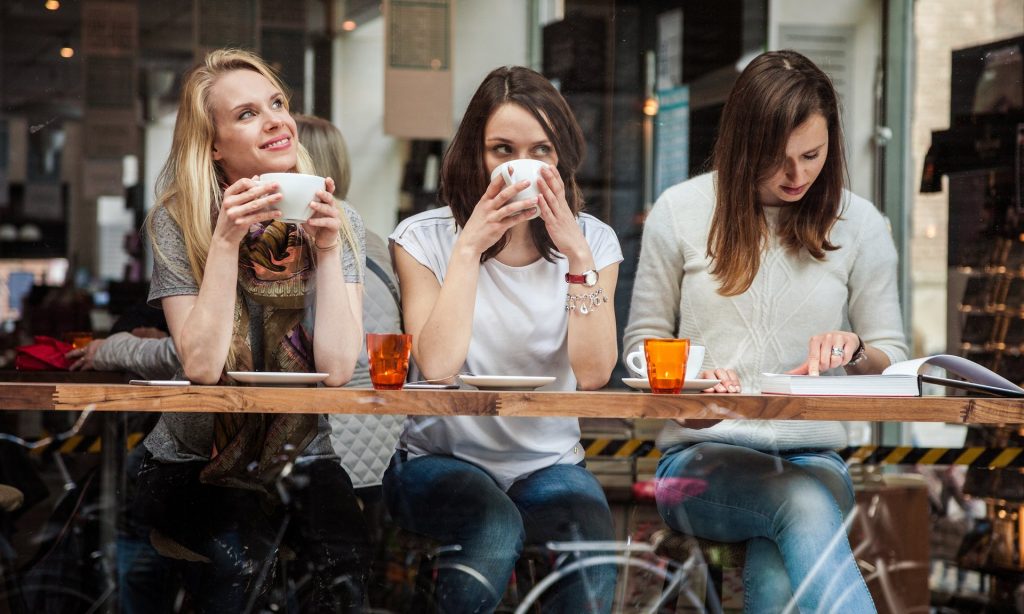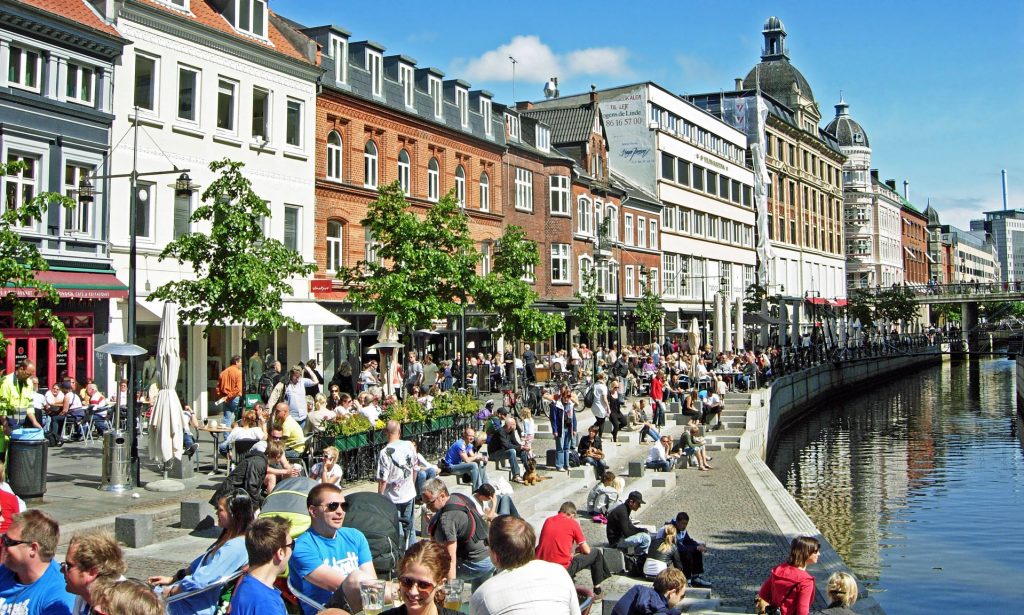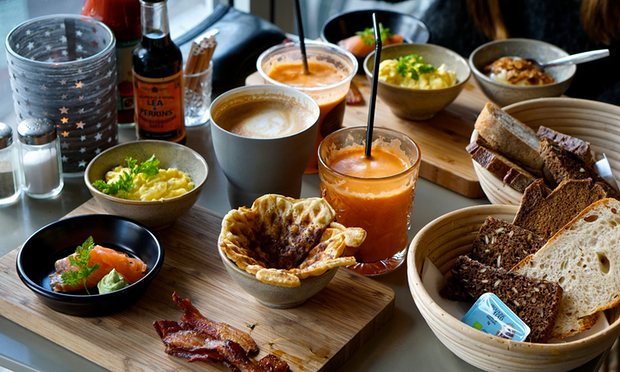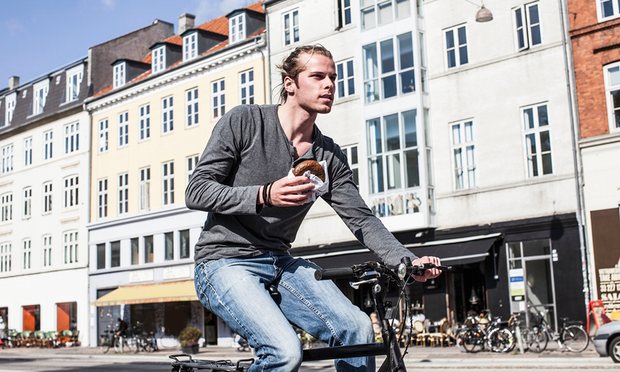
Photograph: Leonardo Patrizi/Getty Images
Jeppe Trolle Linnet’s gaze dances around Bang & Jensen, his favourite Copenhagen café-bar, seeking out anything and everything that brings it hygge, that untranslatable quality of places, people and togetherness prized by Danes above almost all else.
“It’s the candles, obviously … the lighting. It’s not like they have big lamps on the ceiling,” he says. Then the furnishings: “You get the feeling that, ‘hmm, this must have been brought in from various places’.” He gestures at the flip-down seats we’re sitting on. “Like an old cinema. So probably someone knew someone. Just by the look of it, it suggests that people here are connected to someone, so the whole place is full of sociality, even when it’s empty.” He rubs the shiny brass where his feet are resting. “And obviously it’s all pretty worn, you feel that if you put your feet up, it wouldn’t really matter.”
Linnet published the first academic paper on hygge five years ago, since when he has become the go-to expert for Danish journalists, particularly around Christmas, when hygge is paramount.
If this is the first you’ve heard of hygge, pronounced “hue-guh” and usually translated as “cosiness”, you are about to hear a whole lot more.
Five books on the subject are hitting the shelves this autumn. There’s The Little Book of Hygge by Meik Wiking (subtitled “The Danish way to live well”), out last week. And The Book of Hygge by Louisa Thomsen Brits (subtitled “The Danish art of living well”), out last month. Coming later this week is The Art of Hygge, whileHow to Hygge and Hygge: A Celebration of Simple Pleasures, Living the Danish Way, are both out next month.
“It’s the new black,” laughs Agnete Wulff, whose husband Poul owns Wulff & Konstali Food Shop, reputedly the Danish capital’s most hygge place for breakfast, where I drop in first thing in the morning.

Photograph: Getty Images/iStockphoto
Agnete says hygge was the single most important thing when Poul started his basement bistro 14 years ago. International interest, though, is very recent. “It’s because we live such a stressful life, everybody is so busy,” she says. “It’s important when we have the moment that we can hygge. They forget to de-stress maybe in London. When I went to London it was all about alcohol and shopping!”
She starts me off with a tebirke, a pastry consisting almost exclusively of butter and sugar, coated with poppy seeds. Then she and Poul drive me from their cosy café near the old harbour at Islands Brygge to the bigger branch in nearby Amager.
“Hygge is when you treat yourself, it’s not that healthy, but it’s good food,” Agnete says.
“We are very proud of this word hygge,” Poul adds. “Everybody has a little laugh when you say hygge.”
This is strikingly true. Throughout the day, everyone I mention hygge to breaks into a broad smile. Danes talk about hygge the way Italians talk about food. This might be why in his book Wiking, the chief executive of the Happiness Research Institute in Copenhagen, proposes it as “the overlooked ingredient in the recipe for Danish happiness”. It is, he writes, along with the social equality and life security born of the welfare model, the reason why Danes are ranked as the world’s most contented people in surveys year after year.
Places like Wulff & Konstali and Bang & Jensen have perfected the art of providing hygge-to-order for busy Copenhageners, making the city arguably the best place for foreigners to experience this particular brand of laidback informal homeliness.
Otherwise, hygge largely happens behind closed doors, accessible only to foreigners lucky enough to know a patient and welcoming Dane.
Hygge is perhaps most associated with hunkering down with cocoa and candlelight on a cold and rainy evening, but it can also be the gentle good time of a summer bicycle ride.
Whatever it is, as I sit soaking in the sun in Amager, I am painfully conscious that I’m not feeling it.
The brunch, probably the most Instagrammed in the city, is wonderful – bacon, egg, porridge, fruit and other goodies all arranged in little ceramic bowls on a wooden plank. But my mind is racing about where to go next. I’m not relaxing, and I’m alone.
According to Agnete, hygge is not an easy state to achieve, and difficult, if not impossible, to have by yourself. “There’s a lot of work behind hygge, you have to think about it, and you have to agree what’s hygge for everybody,” she says.
It also benefits from familiarity. Bang & Jensen is not hygge for Linnet simply because of the decor, but because he lives around the corner.

But even when hygge is established, it is easily destroyed. “The hygge can disappear just like that,” Agnete says and clicks her fingers. “When someone says something wrong, you can feel it, it makes a suction through your body.”
At her cafés, for example, the younger waiting staff now have different music tastes from the owners. Even this tiny tension is a threat to the hygge.
“It’s just so much easier if they share those preferences,” Linnet agrees when I tell him this. “People should stick to the common denominator of the group that they’re with and not, for example, bring topics on to the table that can make it clear that they aren’t as similar as they seem.”
It is rarely hygge to talk about politics, or indeed anything controversial. Hygge is linked etymologically to the word “hug”. It has a sense of encirclement, of boundaries, of a safe space.
“There’s a dark side that’s easy to skim over in our desire to present hygge as our latest lifestyle fad,” admits Thomsen Brits, whose mother is Danish and whose book, with its quotes from the Danish writer Søren Kierkegaard, presents hygge as a philosophy of mindful living, of presence in the moment. “I think that to create a kind of enclosing embrace or a cluster of warmth, there’s always going to be the experience of sitting on the outside of that circle of warmth, there are definitely shadows on the periphery of hygge. There’s an element of social control.”
Hygge’s opposite, uhyggelig, does not mean “uncomfortable” as you might expect, but “scary”.
When I go to King’s Garden, the park surrounding Copenhagen’s Rosenborg Castle, to see the picnics in the park that are a form of summer hygge, I meet two Danish teachers with a group of Iraqi schoolchildren.

“Iraqis don’t have hygge,” they maintain. “The other Iraqi teachers don’t understand that you don’t walk around during a meal, and the level of noise they make is not hygge.”
Linnet disagrees that immigrants and foreigners can’t experience hygge. Having a pint or two, but no more, in a good English pub, he points out, is just about the most hygge thing you can do.
But will this year’s flurry of books teach the British to embrace hygge more fully? He doubts it.
“I think it’s possible to market it and turn it into something which fascinates people, but I don’t know if the consumers in the UK or in the US will feel that they’re experiencing anything very unique,” Linnet says.
At its best, the craze for hygge could encourage a love of simplicity, a rejection of expensive brands and conspicuous consumption, a renewed focus on the social relations that really matter. At worst, it could boil down to a way of selling candles and Danish designer lighting.
“If you get a list of things to put in your home to make it more hygge, I don’t think it works,” he says. “You can’t just go out with your high salary and just buy hygge like a package that you can install. You need to spend time on it.”

